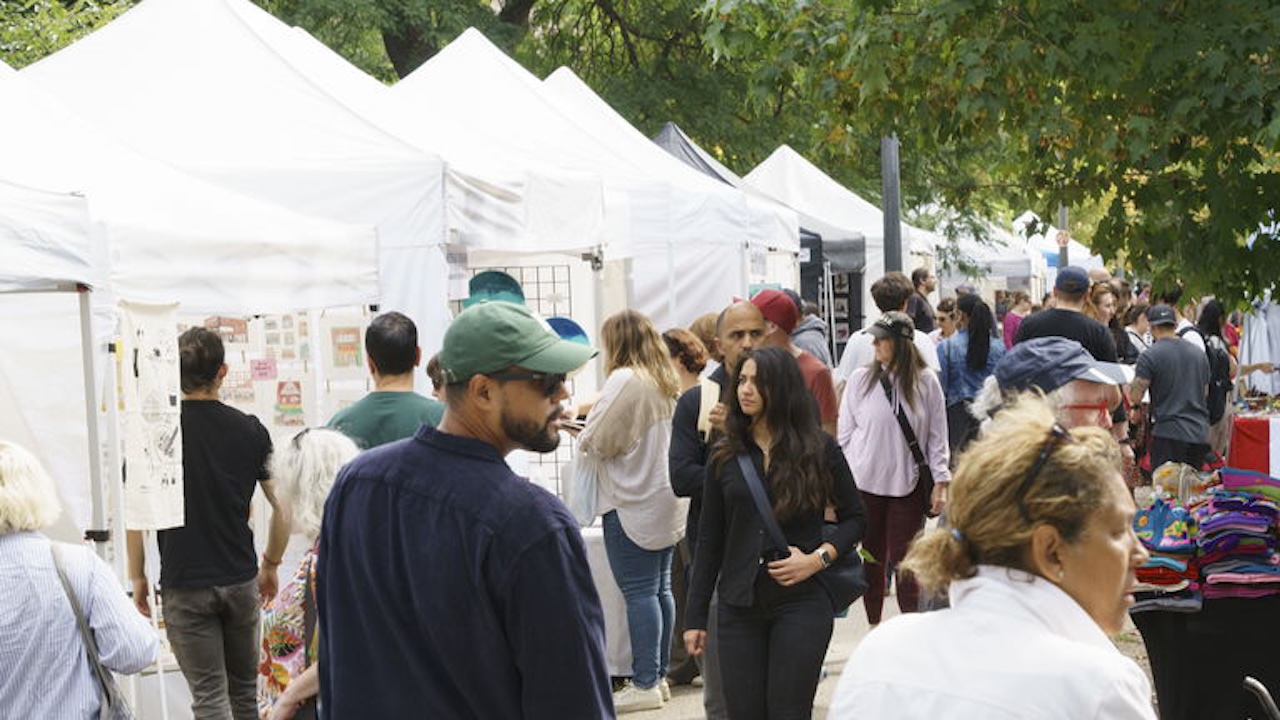Leah Carmichael, painting the hyena for Life of Pi, Puppet Stuff Canada. Citadel Theatre, photo supplied.
By Liz Nicholls, .ca
 It would seem to define the impossible: the page-to-live stage adventure of Life of Pi, Yann Martel’s 2001 Booker Prize-winning novel.
It would seem to define the impossible: the page-to-live stage adventure of Life of Pi, Yann Martel’s 2001 Booker Prize-winning novel.
To help support .ca YEG theatre coverage, click here.
A story about an Indian teenager lost at sea for 227 days? Afloat on a lifeboat in the boundless Pacific in the company of a shipwrecked menagerie of zoo animals, and finally a Bengal tiger?
It’s been a movie, yes, (Ang Lee, 2012). But theatre magic requires a much different kind of imaginative participation, from artists and audiences. It’s transported Lolita Chakrabarti’s 2019 stage adaptation from northern England to the West End and on to Broadway. And now, for the first time at a regional theatre in this country, Life of Pi is happening on the Shoctor stage at the Citadel in a co-production with the Royal Manitoba Theatre Centre co-production, starting previews Saturday.
The design and building of the animal characters led by Richard Parker, the fearsome tiger with the whimsical name, is the work of Calgary-based Puppet Stuff Canada. And the lead designer/sculptor Brendan James Boyd, the company co-founder (with Reese Scott) and a passionate career inhabitant of the world of puppets, is on the phone to explain the particular challenges of the production we’ll see.
“Gargantuan!” says Boyd, an Edmontonian who moved to Calgary five years ago to work on the Apple+ Fraggle Rock reboot series Back To the Rock. “So exciting to come back to theatre on this scale!” he says of his return from the film and TV gigs of the last few years. If you fell in love with Olaf the adorable snowman in the Citadel production of Frozen the Disney Musical last winter you know something about Puppet Stuff creativity. “That was our re-entry. We were the last-minute choice,” says Boyd, “and we had a month!”
Life of Pi was years in development before its stage debut at the Crucible in Sheffield England, and “they’re now on their seventh iteration (of the puppets)…. We’re doing it in way less time (two months) with significantly less resources,” says Boyd. “This was a challenging build! They asked us to do something different from the established show.”
Start with this test of ingenuity: the logistics and choreography involved way fewer puppeteers. In London the six or eight puppeteers of the West End production, who give the zebra, the hyena, the orangutan, the goat, and super-star tiger Richard Parker the breath of life, were nominated for a supporting actor Olivier Award. Here, the cast includes only two dedicated puppeteers (Troy Feldman and Braydon Dowler-Coltman), Boyd explains. “And the 14-member ensemble jumps in to (puppeteer) when possible.”
Boyd is delighted by the continuing collaboration — with director Haysam Kadri, the actors, the design team led by Beyata Hackborn — this demanded. “A lot of what we do is third-party. Here, we were in there from the start with the production,” a collaboration updated constantly. And fine-tuning will happen till opening night, Boyd figures.

Leah Carmichael of Puppet Stuff Canada, working on Life of Pi, Citadel Theatre. Photo supplied.
Originality was required — in the weight of the puppets, the aesthetic, the movement lexicon. “We built the tiger from the ground up,” Boyd says. There are no blueprints, no instructions. It’s not like Little Shop of Horrors where the instructions for building the plant (the carnivorous Audrey II) are included in the front of the libretto. We had to make this up from scratch.”
Boyd and his Puppet Stuff team-mates made cardboard miniatures for the initial workshops. Director Kadri (whose production of Heist was at the Citadel last season) “wanted to keep the puppets in the scale of real animals,” neither reduced in size nor abstract.
“For me, I speak mostly through sculpture. When I design for clients I don’t sketch on paper; I sketch with water-based clay, and quickly sketch out a shape and a silhouette. That’s how I get inspired…. It’s impulsive, very emotional. You get that artistic fervour when you get what’s in your head out into clay…. That’s the raw first pass, and there’s something beautiful about it, and something does get lost in the process of refinement.”
So Boyd and co set about translating those first passes into puppets. The originals, as he points out, were hand-sculpted, hand-carved, and beautiful…. But we didn’t have the time or the staff to do that.” So they alighted on the idea of using full-scale 3-D scan printouts to capture the initial artistic impulses. “Life-sized, and in the case of Richard Parker, even a hair bigger,” says Boyd, in the interest of “making Richard Parker an aggressive form onstage, more threatening.” Be warned: “when he glares at you, in the face, it’s quite intimidating!”
“Every week we’re constantly re-jointing the legs, or the neck, adjusting for all the little nuances the performers figure out…. The two puppeteers (Dowler-Coltman and Feldman), both movement-based artists, are fantastic, very collaborative.” And the puppets themselves … well, as Boyd points out, “generally in theatre they tell you what they want to do, and you have to adjust accordingly.”
The largest of the puppets (who has to be the lightest) is the zebra. A single human performer brings the hyena to life. Each puppet presents their own challenges, especially with person-power at such a premium. It’s a balance, thinks Boyd who personally hand-sculpted all the faces. “Because of the limitations the puppeteers help sell the characters, with the movement of their bodies. They help fill in the information for the imagination….”
As you might guess, the tiger is the most complex and challenging of all. At core inside the tiger, Richard Parker is an athletic human being “with a crutch/stilt configuration.” And it will not surprise you to learn that “it’s incredibly hard to fit a human into any animal profile.”
The infrastructure is plastic, Boyd explains. “We managed to 3-D print it SO thin, 2 mm shells …. Mostly in puppetry you build from the inside out. For this we worked from the outside in. Which gave us room to adjust the mechanics.” And that thinness gives the puppets a kind of shine, almost a translucency.”
The original aesthetic inspiration of the West End touring show, as the English puppet-makers have said in interviews, was driftwood. Boyd and Puppet Stuff are thinking “shipwreck, water, wave formation.” And in this they work in tandem with lighting designer April Viczko and sound designer Joelysa Pankanea. “Puppets take a team!”
And there’s sustainability to consider too, as Boyd points out, since Pi’s traumatic journey at the Citadel is followed by another in Winnipeg. “I have never built puppets that had to go through so much vigorous use and stress. They take a beating…. I mean, they kill each other!” Puppetry director Dayna Tietzen, a puppeteer and movement specialist herself, “goes to bat for the puppets,” as Boyd puts it.
“We swore we’d never build puppets again for people,” Boyd laughs of his Puppet Stuff plan with Scott of five years ago to “just sell supplies, hence the name — fleece and foam and sculpting tools. Very quickly people started asking us to build again. And that’s been our trajectory. Now we’re building for companies all across North America.” If you’re hot to have a 16-foot puppet climb a 41-storey building, Puppet Stuff is your go-to.
A home base in Calgary is a natural terroir: “the puppet capital of Canada” is a mysterious vortex of puppets and their human collaborators, with at least six puppet companies, including the Old Trout Puppet Workshop and the Green Fools (it’s where marionettist Ronnie Burkett made his start), and 54 independent puppeteers. “I’ve gone on many journeys in my life,” Boyd laughs, “many forks in the road.” But the five-year-old who saw a marionette show at a festival and said “I’m going to be a puppet man when I grow up” stuck to his GPS.
“”Everyone who works in our collective is a puppeteer, and very talented performer in their own right,” Boyd says of his cohorts, who also write, direct, and perform. “At least once a year we all devise a show together.” The Boo Revue, their cabaret-style “passion project” family musical, which embraces hand puppets and bunraku puppets (Boyd’s own favourite), has taken to touring — it’ll be at the Arden Theatre in St. Albert Oct. 26. “It’s our chance to try new things,” a impulse he compares to Burkett’s free-wheeling Daisy Theatre.
Meanwhile, Puppet Stuff’s return to theatre from film and TV has excited the collective. “Theatre is thrilling and it lives in a different way in space in front of people. We fill in the gaps with our imaginations….” That’s something puppets demand of their audiences. And Life of Pi is “the Olympics of puppetry!”
PREVIEW
Life of Pi
Theatre: Citadel and Royal Manitoba Theatre Centre
Written by: Lolita Chakrabarti, adapted from the Yann Martel novel
Directed by: Haysam Kadri
Starring: Davinder Malhi, Deena Aziz, Omar Alex Khan, Andrea Cheung, Bailey Chin, Braydon Dowler-Coltman, Troy Felman, N. Girgis, Kevin Klassen, Azeem Nato, Kristen Padayas, Garett Ross, Anaka Maharaj-Sandhu, Suchiththa Wickremesooriya
Running: Saturday (in preview) through October. 5
Tickets: citadeltheatre.com, 780-425-1820
















